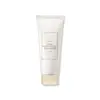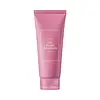What's inside
What's inside
 Key Ingredients
Key Ingredients

No key ingredients
 Benefits
Benefits

 Concerns
Concerns

 Ingredients Side-by-side
Ingredients Side-by-side

Glycerin
HumectantWater
Skin ConditioningSodium Cocoyl Isethionate
CleansingMyristic Acid
CleansingPotassium Cocoyl Glycinate
Niacinamide
SmoothingMethylpropanediol
SolventPolyquaternium-7
Butylene Glycol
HumectantEthylhexylglycerin
Skin ConditioningCaprylyl Glycol
Emollient1,2-Hexanediol
Skin ConditioningOryza Sativa Extract
AbsorbentDisodium EDTA
Oryza Sativa Bran Extract
Skin ConditioningSteareth-30
CleansingCaramel
Cosmetic ColorantSodium Benzoate
MaskingDextrin
AbsorbentGlycerin, Water, Sodium Cocoyl Isethionate, Myristic Acid, Potassium Cocoyl Glycinate, Niacinamide, Methylpropanediol, Polyquaternium-7, Butylene Glycol, Ethylhexylglycerin, Caprylyl Glycol, 1,2-Hexanediol, Oryza Sativa Extract, Disodium EDTA, Oryza Sativa Bran Extract, Steareth-30, Caramel, Sodium Benzoate, Dextrin
Water
Skin ConditioningGlycerin
HumectantPalmitic Acid
EmollientFicus Carica Fruit Water
MaskingStearic Acid
CleansingLauric Acid
CleansingMyristic Acid
CleansingPotassium Hydroxide
BufferingGlyceryl Stearate
EmollientPEG-100 Stearate
Synthetic Beeswax
Emulsion StabilisingSodium Methyl Cocoyl Taurate
CleansingPotassium Cocoyl Glycinate
Polyquaternium-7
Ethyl Hexanediol
SolventCocamidopropyl Betaine
Cleansing1,2-Hexanediol
Skin ConditioningGlyceryl Caprylate
EmollientPEG-14m
Emulsion StabilisingDisodium EDTA
Sodium Chloride
MaskingHydroxyethylcellulose
Emulsion StabilisingButylene Glycol
HumectantFicus Carica Fruit Extract
HumectantSodium Benzoate
MaskingSapindus Mukorossi Fruit Extract
Skin ConditioningFicin
Skin ConditioningPolysorbate 60
EmulsifyingDisodium Phosphate
BufferingSodium Phosphate
BufferingParfum
MaskingWater, Glycerin, Palmitic Acid, Ficus Carica Fruit Water, Stearic Acid, Lauric Acid, Myristic Acid, Potassium Hydroxide, Glyceryl Stearate, PEG-100 Stearate, Synthetic Beeswax, Sodium Methyl Cocoyl Taurate, Potassium Cocoyl Glycinate, Polyquaternium-7, Ethyl Hexanediol, Cocamidopropyl Betaine, 1,2-Hexanediol, Glyceryl Caprylate, PEG-14m, Disodium EDTA, Sodium Chloride, Hydroxyethylcellulose, Butylene Glycol, Ficus Carica Fruit Extract, Sodium Benzoate, Sapindus Mukorossi Fruit Extract, Ficin, Polysorbate 60, Disodium Phosphate, Sodium Phosphate, Parfum
 Reviews
Reviews

Ingredients Explained
These ingredients are found in both products.
Ingredients higher up in an ingredient list are typically present in a larger amount.
1,2-Hexanediol is a synthetic liquid and another multi-functional powerhouse.
It is a:
- Humectant, drawing moisture into the skin
- Emollient, helping to soften skin
- Solvent, dispersing and stabilizing formulas
- Preservative booster, enhancing the antimicrobial activity of other preservatives
Butylene Glycol (or BG) is used within cosmetic products for a few different reasons:
Overall, Butylene Glycol is a safe and well-rounded ingredient that works well with other ingredients.
Though this ingredient works well with most skin types, some people with sensitive skin may experience a reaction such as allergic rashes, closed comedones, or itchiness.
Learn more about Butylene GlycolDisodium EDTA plays a role in making products more stable by aiding other preservatives.
It is a chelating agent, meaning it neutralizes metal ions that may be found in a product.
Disodium EDTA is a salt of edetic acid and is found to be safe in cosmetic ingredients.
Learn more about Disodium EDTAGlycerin is already naturally found in your skin. It helps moisturize and protect your skin.
A study from 2016 found glycerin to be more effective as a humectant than AHAs and hyaluronic acid.
As a humectant, it helps the skin stay hydrated by pulling moisture to your skin. The low molecular weight of glycerin allows it to pull moisture into the deeper layers of your skin.
Hydrated skin improves your skin barrier; Your skin barrier helps protect against irritants and bacteria.
Glycerin has also been found to have antimicrobial and antiviral properties. Due to these properties, glycerin is often used in wound and burn treatments.
In cosmetics, glycerin is usually derived from plants such as soybean or palm. However, it can also be sourced from animals, such as tallow or animal fat.
This ingredient is organic, colorless, odorless, and non-toxic.
Glycerin is the name for this ingredient in American English. British English uses Glycerol/Glycerine.
Learn more about GlycerinMyristic Acid is a saturated fatty acid. It is naturally found in milk fat. Other sources include palm oil, coconut oil, and butter fat.
Myristic Acid is an emulsifer and cleanser. As an emulsifer, it stabilizes a product by preventing ingredients from separating. Myristic Acid helps clean your skin by acting as a surfactant. It tends to gather oil and dirt on your skin to be easily rinsed away.
One study from 2021 found Myristic Acid to have anti-inflammatory properties.
Learn more about Myristic AcidPolyquaternium-7 is a light to clear colored liquid. It is commonly found in haircare products for its film-forming and anti-static properties.
According to a manufacturer, it is a non-paraben and specially developed for negatively charged surfactant systems. This makes it a great hairstyle holder and helps to improve wet hair detangling without adding buildup.
Potassium Cocoyl Glycinate is an amino acid-based surfactant and cleaning agent. This ingredient can be derived from animals or plants. It may also be synthetically created from fatty acids of the coconut and glycine.
Potassium Cocoyl Glycinate is a gentle surfactant. Surfactants help gather the dirt, oil, and other pollutants from your skin to be rinsed away. It is a mild cleanser and naturally produces foam.
Sodium Benzoate is a preservative. It's used in both cosmetic and food products to inhibit the growth of mold and bacteria. It is typically produced synthetically.
Both the US FDA and EU Health Committee have approved the use of sodium benzoate. In the US, levels of 0.1% (of the total product) are allowed.
Sodium benzoate works as a preservative by inhibiting the growth of bacteria inside of cells. It prevents the cell from fermenting a type of sugar using an enzyme called phosphofructokinase.
It is the salt of benzoic acid. Foods containing sodium benzoate include soda, salad dressings, condiments, fruit juices, wines, and snack foods.
Studies for using ascorbic acid and sodium benzoate in cosmetics are lacking, especially in skincare routines with multiple steps.
We always recommend speaking with a professional, such as a dermatologist, if you have any concerns.
Learn more about Sodium BenzoateWater. It's the most common cosmetic ingredient of all. You'll usually see it at the top of ingredient lists, meaning that it makes up the largest part of the product.
So why is it so popular? Water most often acts as a solvent - this means that it helps dissolve other ingredients into the formulation.
You'll also recognize water as that liquid we all need to stay alive. If you see this, drink a glass of water. Stay hydrated!
Learn more about Water